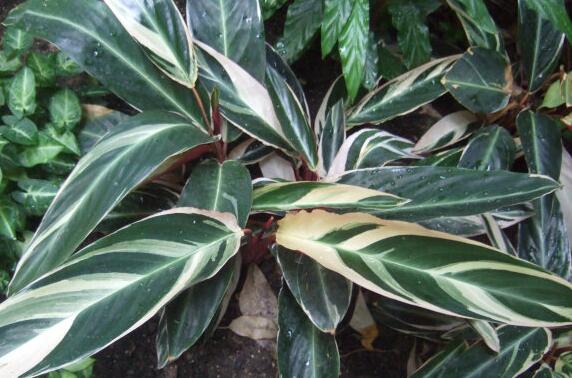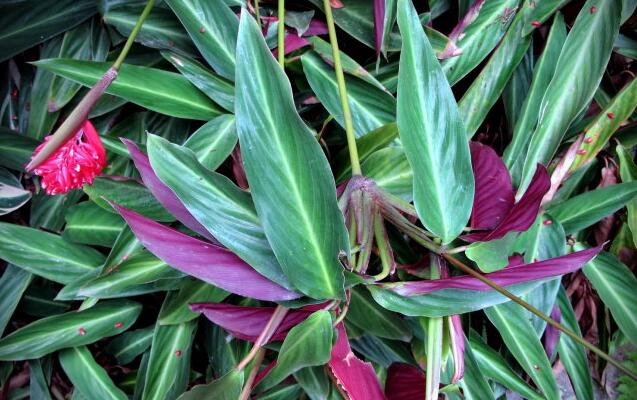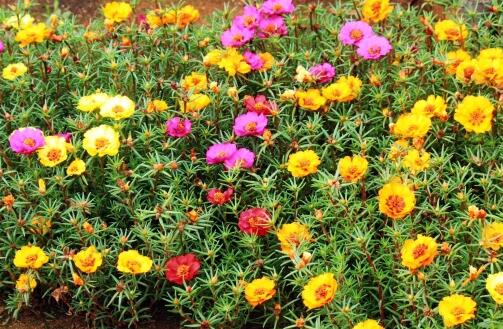How to control the diseases and insect pests of purple back taro?
Amorphophallus mandshurica has strong resistance and few diseases and insect pests, but diseases and insect pests still occur when it is not well managed in the process of cultivation. The common pests are shell insects, red spiders and so on, and the common diseases are white silk disease and leaf spot disease. What are the diseases and insect pests of the purple back taro? How to prevent and cure it?

Diseases of purple back taro:
White silk disease
White silk disease often occurs in purple back taro. When the white silk disease occurs, the stems or leaves of the purple back taro will turn brown and rot and grow white silky mycelium, causing the aboveground parts to wither and die. The disease is more serious from July to August, and the pathogen is Sclerotinia sclerotiorum. It is easy to occur when the soil is too wet, barren and lack of fertilizer.
Control method: when the white silk disease of purple back bamboo taro occurs, 70% pentachloronitrobenzene can be added to the soil to disinfect the soil, remove the diseased soil, and pay attention to ventilation during cultivation to prevent planting from being too dense.
Leaf spot disease
Leaf spot mainly harms leaves and leaf sheath. There are small spots on the leaves at the initial stage of the disease, and then become larger. The disease can occur all the year round. in the peak period of the disease, it can dry up a large number of leaves and cause serious damage.
Prevention and control methods: increase the application of base fertilizer, enhance disease resistance, and remove diseased leaves in time. Spray 75% chlorothalonil wettable powder 500-600 times before onset of the disease.
Insect pest of purple back taro:
Shell worm
Scale insects are mainly pink scale, they suck plant juice by piercing mouthparts, light leaves turn yellow and aging, affect plant growth, serious defoliation, until the whole plant dies. However, because the adults of scale insects have a waxy shell, it is difficult for pesticides to enter, and once it occurs, it is more difficult to control.
Control methods: shell insects are easy to kill when spraying in the peak period of nymphs. Spray once every 7-10 days, 2-3 times in a row. It can be sprayed with 1000 times of omethoate or 1000 times of dichlorvos and 3000 times of 2.5% deltamethrin.
Red spider
The harm of red spiders to plants is more common. Red spiders absorb nutrients from leaves with sharp needles, affecting the normal growth and development of plants. In the high temperature and dry environment, red spiders reproduce rapidly and do serious harm.
Prevention and control methods: maintain environmental ventilation, maintain humidity, leaf back often spray water can control the reproduction of red spiders. As pesticides are difficult to kill eggs, they are generally controlled in the adult and nymph stage after hatching, and can be sprayed with 1000 times of dicofol EC or 1000 times of omethoate EC.
Diseases and insect pests of purple back bamboo taro and its control
The disease of purple back bamboo taro, white silk disease
White silk disease often occurs in purple back taro. When the white silk disease occurs, the stems or leaves of the purple back taro will turn brown and rot and grow white silky mycelium, causing the aboveground parts to wither and die. The disease is more serious from July to August, and the pathogen is Sclerotinia sclerotiorum. It is easy to occur when the soil is too wet, barren and lack of fertilizer.
Control method: when the white silk disease of purple back bamboo taro occurs, 70% pentachloronitrobenzene can be added to the soil to disinfect the soil, remove the diseased soil, and pay attention to ventilation during cultivation to prevent planting from being too dense.
Leaf spot disease
Leaf spot mainly harms leaves and leaf sheath. There are small spots on the leaves at the initial stage of the disease, and then become larger. The disease can occur all the year round. in the peak period of the disease, it can dry up a large number of leaves and cause serious damage.
Prevention and control methods: increase the application of base fertilizer, enhance disease resistance, and remove diseased leaves in time. Spray 75% chlorothalonil wettable powder 500-600 times before onset of the disease.
The insect scale of the purple-backed taro
Scale insects are mainly pink scale, they suck plant juice by piercing mouthparts, light leaves turn yellow and aging, affect plant growth, serious defoliation, until the whole plant dies. However, because the adults of scale insects have a waxy shell, it is difficult for pesticides to enter, and once it occurs, it is more difficult to control.
Control methods: shell insects are easy to kill when spraying in the peak period of nymphs. Spray once every 7-10 days, 2-3 times in a row. It can be sprayed with 1000 times of omethoate or 1000 times of dichlorvos and 3000 times of 2.5% deltamethrin.
Red spider
The harm of red spiders to plants is more common. Red spiders absorb nutrients from leaves with sharp needles, affecting the normal growth and development of plants. In the high temperature and dry environment, red spiders reproduce rapidly and do serious harm.
Prevention and control methods: maintain environmental ventilation, maintain humidity, leaf back often spray water can control the reproduction of red spiders. As pesticides are difficult to kill eggs, they are generally controlled in the adult and nymph stage after hatching, and can be sprayed with 1000 times of dicofol EC or 1000 times of omethoate EC.
Is the purple back taro poisonous? The culture method of purple back taro and the flowering period of purple back taro
Purple-backed taro is a perennial herb of the family Amorphophallus, and it is an indoor shade-loving foliage plant, so what is it? There will be such charm, it has how to cultivate, the editor will talk about this knowledge in detail for you today. . Introduction of purple back taro the whole plant is about 1 meter, upright. Leaf blade long ovate or lanceolate. Its branches and leaves grow densely, the plant shape is plump, thick leathery, the leaf surface is dark green and glossy, the midrib is light, the leaf back is blood red, and the leaf forms a sharp contrast, very beautiful. Spikes, bracts and calyx bright red, petals white. The back is fuchsia. . The growth environment of Amorphophallus angustifolia is native to Central America and Brazil, and is cultivated in many provinces in southern China. It likes warm and humid climate and grows in a shady environment; the optimum temperature for growth is 20-30 ℃, which requires a lot of water and is not resistant to drought. More heat-resistant, slightly cold-resistant, more than 5 ℃ can safely pass the winter. . The culture method of purple back bamboo taro mainly uses the separate plant method to propagate, and several points should be guaranteed during the culture period. Soil: purple back taro likes fertile, loose and moist acid soil with good drainage. Pot cultivation can use rotten leaf soil and river sand to mix evenly, add a small amount of base fertilizer as soil cultivation. To ensure the nutrition and permeability of the cultivated soil. In the growing season, liquid fertilizer is applied twice a month to ensure its growth and promote its branches and leaves to flourish. In addition, the basin is turned once every 1-2 years. . Key points for the maintenance of purple-backed taro: purple-backed taro is an excellent indoor shady foliage plant. In order to prevent sun exposure in hot summer, 70%, 80% of the light should be covered, otherwise it is easy to cause injury; the leaves will fade and become dull; but they should not be placed in a dark and poorly ventilated place for a long time to avoid yellowing and shedding of leaves. . watering: the purple back taro is not resistant to drought, so it is necessary to ensure sufficient water during the growth period, keep the basin soil moist, and often spray water to the leaves; especially in the summer and autumn high temperature season, when the air is dry, it is often necessary to spray water on and around the leaves to maintain high air humidity. Be careful not to make the basin soil stagnant, so as not to affect root ventilation, resulting in poor growth or rotten roots; if the temperature is low after the end of autumn, it is necessary to control the amount of water and keep the basin soil slightly wet. Pest control: the common diseases of purple back taro are leaf spot and leaf blight. At the initial stage of the disease, Bordeaux solution was sprayed 2-3 times every 15 days. It can also be sprayed with Dysen zinc wettable powder solution. The common insect pests are mainly shell insects, which are easy to occur when the ventilation is poor. . Introduction to the flowering period of purple-backed taro, purple-backed taro is mainly a foliage plant. Basically, if the temperature is kept above 25 ℃ in a year or so, it will blossom, but its flower is slightly inferior to its colorful leaves, which is why many people do not know whether it will bloom or not. . Introduction to the toxicity of purple-backed taro is non-toxic, it is mainly made of potted plants for indoor decoration, is an excellent indoor shade-loving foliage plant, can be watched for a long time. It can not only add a little bit of vitality, but also bring a good mood. . This is the end of the editor's summary of the knowledge about purple-backed taro. This kind of plant is especially good for potted plants. Friends who like it can plant a pot by themselves and put it at home or in the office. It's all good! For more information about flowers, you can click on the link below!
- Prev

It is necessary to find out the cause of the yellowing of purple-backed taro leaves in advance.
Purple back bamboo taro branches and leaves dense growth, plant shape plump, thick leathery, leaf dark green glossy, midrib light color, leaf back blood red, forming a sharp contrast. Spikes, bracts and calyx bright red, petals white. The back is purplish red
- Next

What are the symptoms of diabetes?
The common diseases of scutellaria barbata are blight, which will greatly affect the growth of scutellaria barbata, cause greater harm to us and cause losses to us. Below, Xiaobian will introduce to you the symptoms and prevention methods of pests and diseases of scutellaria barbata
Related
- Fuxing push coffee new agricultural production and marketing class: lack of small-scale processing plants
- Jujube rice field leisure farm deep ploughing Yilan for five years to create a space for organic food and play
- Nongyu Farm-A trial of organic papaya for brave women with advanced technology
- Four points for attention in the prevention and control of diseases and insect pests of edible fungi
- How to add nutrient solution to Edible Fungi
- Is there any good way to control edible fungus mites?
- Open Inoculation Technology of Edible Fungi
- Is there any clever way to use fertilizer for edible fungus in winter?
- What agents are used to kill the pathogens of edible fungi in the mushroom shed?
- Rapid drying of Edible Fungi

